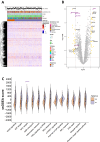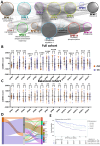Proteomic features of soft tissue tumours in adolescents and young adults
- PMID: 38762630
- PMCID: PMC11102500
- DOI: 10.1038/s43856-024-00522-x
Proteomic features of soft tissue tumours in adolescents and young adults
Abstract
Background: Adolescents and young adult (AYA) patients with soft tissue tumours including sarcomas are an underserved group with disparities in treatment outcomes.
Methods: To define the molecular features between AYA and older adult (OA) patients, we analysed the proteomic profiles of a large cohort of soft tissue tumours across 10 histological subtypes (AYA n = 66, OA n = 243), and also analysed publicly available functional genomic data from soft tissue tumour cell lines (AYA n = 5, OA n = 8).
Results: Biological hallmarks analysis demonstrates that OA tumours are significantly enriched in MYC targets compared to AYA tumours. By comparing the patient-level proteomic data with functional genomic profiles from sarcoma cell lines, we show that the mRNA splicing pathway is an intrinsic vulnerability in cell lines from OA patients and that components of the spliceosome complex are independent prognostic factors for metastasis free survival in AYA patients.
Conclusions: Our study highlights the importance of performing age-specific molecular profiling studies to identify risk stratification tools and targeted agents tailored for the clinical management of AYA patients.
Plain language summary
Soft tissue tumours are cancers that develop in the connective and supporting tissues of the body, such as muscle or fat. These tumours arise in patients across the entire age range. However, improvements in survival outcomes in adolescent and young adult (AYA) patients have lagged behind outcomes in older adults (OA) and children. To better understand the biology of AYA patients with soft tissue tumours, we analysed protein profiles across 10 different types. We identified biological differences between AYA and OA patients and report an age-specific signature that can potentially be used to help predict which AYA patients are more likely to have aggressive cancers that will spread to other parts of the body. Our study highlights the importance of performing age-specific studies to identify new tools to predict patient outcomes and potentially find more suitable treatments.
© 2024. The Author(s).
Conflict of interest statement
The authors declare no competing interests.
Figures




Similar articles
-
Soft-tissue sarcoma in adolescents and young adults compared with older adults: A report among 5000 patients from the Scandinavian Sarcoma Group Central Register.Cancer. 2019 Oct 15;125(20):3595-3602. doi: 10.1002/cncr.32367. Epub 2019 Jul 9. Cancer. 2019. PMID: 31287163
-
Survival of childhood and adolescent/young adult (AYA) cancer patients in Ireland during 1994-2013: comparisons by age.Ir J Med Sci. 2020 Nov;189(4):1223-1236. doi: 10.1007/s11845-020-02236-0. Epub 2020 May 18. Ir J Med Sci. 2020. PMID: 32424602
-
Addressing the knowledge gap in the genomic landscape and tailored therapeutic approaches to adolescent and young adult cancers.ESMO Open. 2024 Aug;9(8):103659. doi: 10.1016/j.esmoop.2024.103659. Epub 2024 Aug 12. ESMO Open. 2024. PMID: 39137480 Free PMC article.
-
AYA Considerations for Aggressive Lymphomas.Curr Hematol Malig Rep. 2021 Feb;16(1):61-71. doi: 10.1007/s11899-021-00607-7. Epub 2021 Mar 16. Curr Hematol Malig Rep. 2021. PMID: 33728589 Review.
-
Soft Tissue Sarcomas in Adolescents and Young Adults.J Clin Oncol. 2024 Feb 20;42(6):675-685. doi: 10.1200/JCO.23.01275. Epub 2023 Nov 15. J Clin Oncol. 2024. PMID: 37967293 Review.
Cited by
-
Epidemiology and clinicopathological features of soft tissue tumors in adolescents: a cross-sectional study.BMC Pediatr. 2025 Jan 9;25(1):21. doi: 10.1186/s12887-024-05361-2. BMC Pediatr. 2025. PMID: 39789509 Free PMC article.
References
-
- WHO Classification of Tumours Editorial Board. Soft Tissue and Bone Tumours (International Agency for Research on Cancer, 2020).
Grants and funding
LinkOut - more resources
Full Text Sources

